 |
 |
 |
| |
HBV Viral Load Less Than 10,000 copies/mL Is Associated with Significant Risk of Hepatocellular Carcinoma in Chronic Hepatitis B (CHB) Patients: An Update from the R.E.V.E.A.L.-HBV Study
|
| |
| |
Reported by Jules Levin
AASLD, Nov 2-6, 2007, Boston, MA
Uchenna H Iloeje1, Hwai-I Yang2,3, Jun Su1, Chuen-Fei Chen2,3, Chin-Lan Jen2,3, San-Lin You2,3, Chien-Jen Chen2,3 for the R.E.V.E.A.L.-HBV Study Group
1Global Epidemiology and Outcomes Research, Research and Development, Bristol-Myers Squibb, Wallingford, CT, USA; 2Genomics Research Center, Academia Sinica, Taipei, Taiwan; 3Graduate Institute of Epidemiology, College of Public Health, National Taiwan University, Taipei, Taiwan
Note from Jules: In table 4 'Multivariate Cox Regression Analysis', the hazard ratio for HCC on followup for individuals with 300 to 10,000 c/ml compared to reference group (<300, undetectable) was 2.7 and for individuals with 10,000 to 100,000 it was 2.0, for individuals with 1000,000 to 1 million it was 3.0, and for individuals with >1 million it was 5.2.
Author Summary
Previously untreated CHB patients that are currently defi ned as having 'inactive disease' (HBV DNA viral load <104 copies/mL) are assumed to have a low risk of disease progression
- These data show that they are at a signifi cantly higher risk of developing HCC than uninfected persons (HBsAg-seronegative)
- The risk of HCC associated with being CHB infected, even with low levels of viremia (<104 copies/mL), was about 3-fold greater than in uninfected persons
Chronic low level viremia carries a measurable and signifi cant additional risk of HCC when compared to CHB infected persons with chronically undetectable viremia
- There is a 2-3 fold increased risk of HCC in subjects with chronic viremia <105 copies/mL when compared to those with chronically undetectable viremia
These results have been adjusted for chronic elevation of serum ALT which was a signifi cant predictor of HCC development in these analyses
Author Conclusion
CHB patients with HBV DNA <104 copies/mL may not be truly 'inactive'. This analysis showed that CHB patients with low viremia have a signif cant risk of HCC development when compared to uninfected persons and that these patients may need closer monitoring for HCC risk
Males, older subjects or the presence of chronic ALT elevation should be indications for closer monitoring and management of CHB patients with low level viremia.
Introduction
Whether CHB patients with low level viremia (HBV DNA <104 copies/mL) carry little or no risk of disease progression is inconclusive
This analysis aimed to evaluate the risk of disease progression for patients with HBV DNA viral load <104 copies/mL compared to HBsAg-seronegative persons
Methods
A subset of the R.E.V.E.A.L.-HBV study cohort (n=3,584) without liver cirrhosis at baseline or HCV infection (anti-HCV seronegative) and all HBsAg-seronegative subjects without HCV infection (n=18,541) were studied
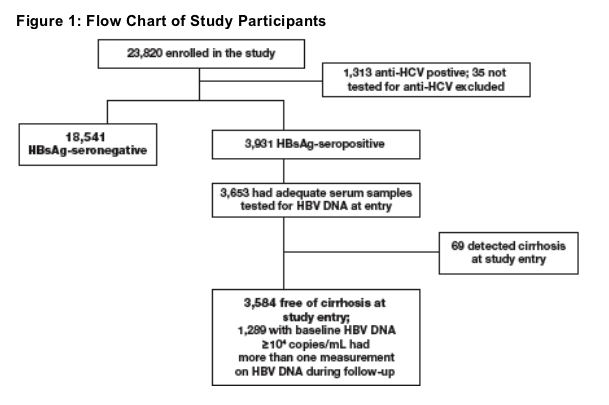
HCC cases were ascertained by computerized data linkage to the National Cancer Registry and Death Certifi cation System in Taiwan.
All HCC cases were confirmed based on either:
- Histopathology
- Two positive coincident image techniques
- One positive image technique with an elevated serum alpha-fetoprotein level >400 ng/mL
Time-dependent Cox proportional hazard models were used to estimate multivariable adjusted hazards ratios
- The risk of HCC for various levels of HBV DNA was compared to HBsAg-seronegative subjects
- Baseline and time-dependent follow-up levels of HBV DNA and ALT were simultaneously modeled
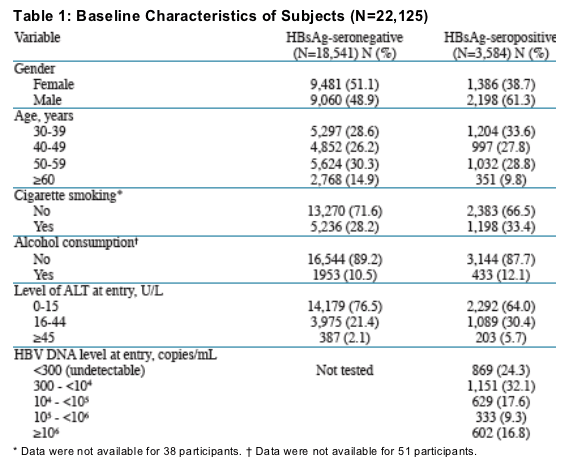
Table 2: Incidence Rate of HCC by Baseline Characteristics (N=22,125).
Incident rate at baseline for HCC was similar for HBsAg+ with <300 c/ml and for those with 300 to 10,000c/ml. Incidence rates were double for cigarette smokers compared to non cigarette smokers, and triple for alcohol users compared to non alcohol users. Incidence rate for cigarette smoking: yes, 118.5/100,000 person years; no, 49.1/100,000 person years. Incidence rate for alcohol consumption: 168/100,000 person years vs 56.9/100,000 person years.
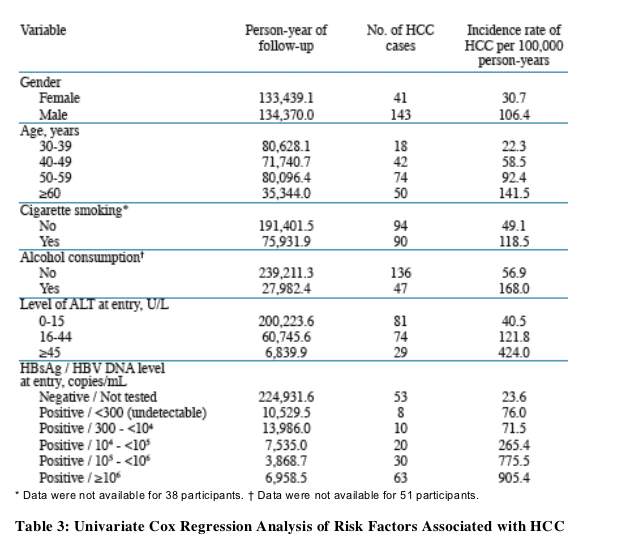
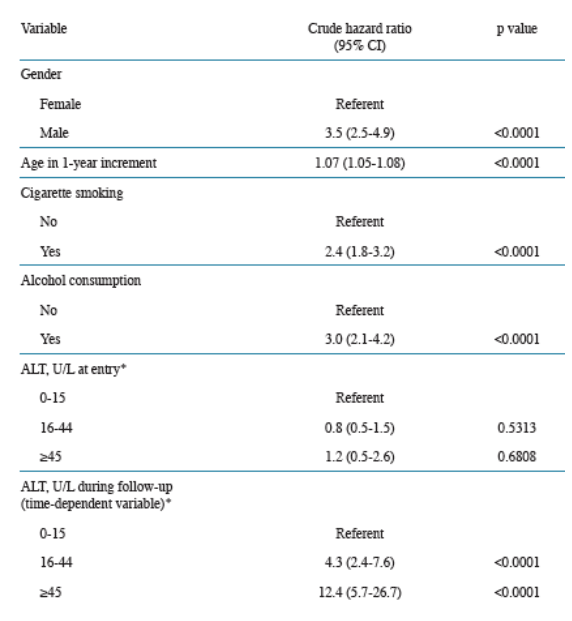
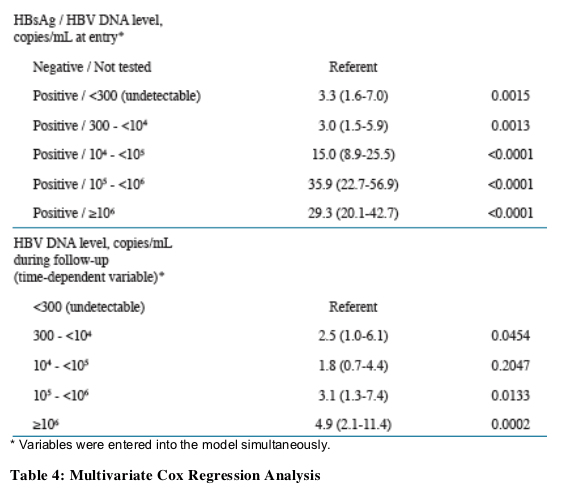
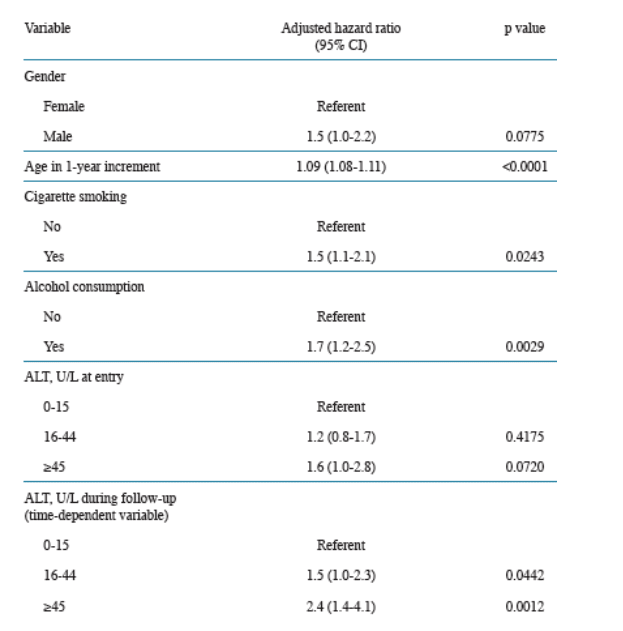
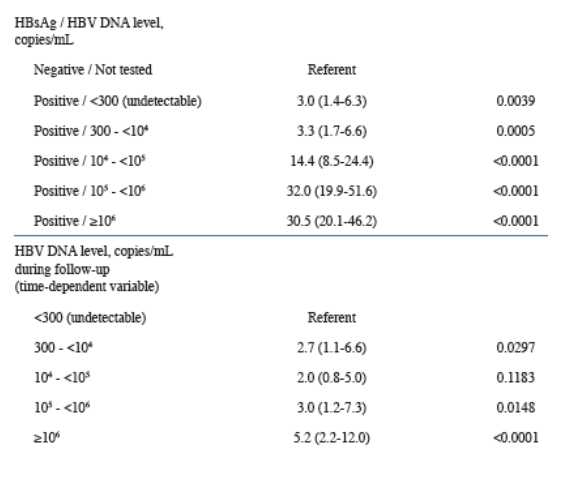
|
| |
|
 |
 |
|
|